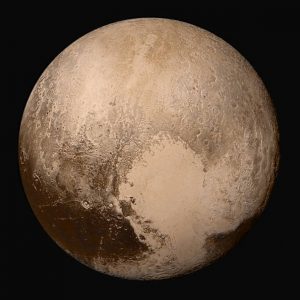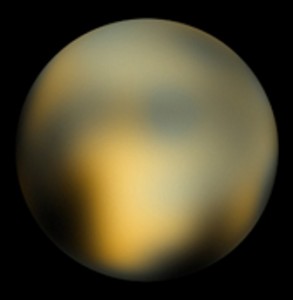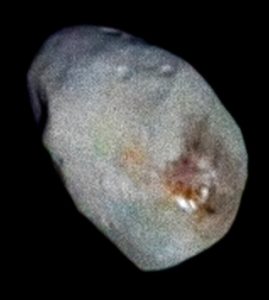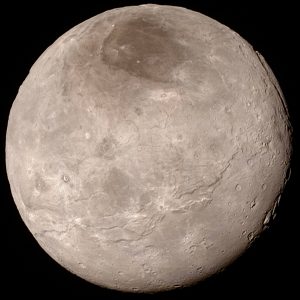
– Click to enlarge

Pluto is a Kuiper belt object, officially classified as a dwarf planet since 2006. Although it is the largest known object in the Kuiper belt, at around 2,374 km in diameter, it is only about two thirds the width of the Earth‘s Moon and about half the diameter of Mercury.
Pluto is an icy world with an eccentric orbit that sometimes brings it closer to the Sun than Neptune, over its 248 year orbital period. Viewed from Pluto, the Sun would appear as just a very bright star in the night sky, 4.6 billion miles away (around 49 AU) at Pluto’s aphelion, and 2.8 billion miles away (around 30 AU) at perihelion.
Pluto’s surface is around 98 per cent Nitrogen ice, although it is believed that Pluto has an internal mantel of water ice surrounding a rocky core around 1700 km in diameter. It is possible that a subsurface ocean of liquid water exists between Pluto’s mantel and core.
Pluto has a thin atmosphere of nitrogen, methane and carbon dioxide.
Pluto Stats:
- Type: Dwarf Planet / Kuiper belt object
- Diameter: 2377 km (0.187 Earths)
- Mass: 1.30×1022 (0.0022 Earths)
- Distance from Sun: 29.658 to 49.305 AU
- Sidereal period (day length): 6 days 9 hours 17 mins, 36 sec
- Orbital period (year length): 248.00 years
- Number of Moons: 5
- Symbol: ♇ (HTML code: ♇)
Discovery
In the early 20th Century, Astronomer Percival Lowell suggested that perceived discrepancies in the orbit of Uranus could be explained by the gravitational influence of a large unknown planet beyond the orbit of Neptune. Clyde Tombaugh was given the task of searching for this new planet, which was given the moniker ‘Planet X’. Tombaugh used a ‘blink comparator’ to compare photographs taken of the same sections of sky, several nights apart, in an area suggested by Lowell. In 1930, Tombaugh eventually found an object that moved relative to the fixed background stars. This object was considered, at the time, to be Planet X and was given the name Pluto, suggested by an 11-year-old girl, in a competition to name the planet. Pluto is the god of the underworld in Roman mythology and the first two letters, which are used in Pluto’s astronomical symbol, are Percival Lowell’s initials.
When the discovery of Pluto’s largest moon, Charon, in 1978, allowed its mass to be calculated, it was found that Pluto was much too small to have the effect on Uranus’ orbit originally ascribed to a Planet X. However, data from Voyager 2’s flyby in 1986, revealed that the mass of Uranus had been overestimated and a Planet X was no longer needed to account for its orbit.
Classification as a Dwarf Planet
Pluto was reclassified as a dwarf planet in 2006, as it does not fulfill the International Astronomical Union’s definition of a planet, newly introduced in that year. This is because, although Pluto is massive enough to be roughly spherical under its own gravity, it has not cleared the neighbourhood around its orbit of planetesimals. However, this definition of a planet is considered by many to be controversial, particularly as Earth would not be large enough to have swept its orbit clear, and therefore would not be defined as a planet, if it were the same distance from the Sun as Pluto, or even Uranus.
See also, the main page on dwarf planets.
New Horizons Probe Visit
New Horizons is a space probe launched by NASA on 19 January 2006, sent to study Pluto and its moons. Making its closest approach to Pluto on 14 July 2015, when it flew within 12,500 km (7,800 miles) of the dwarf planet, New Horizons has given us our first close up views of this icy world and its moons.
Prior to the New Horizons flyby, the best images available to us of Pluto were taken with the Hubble Space Telescope. One such image is shown at the top of this page for comparison with a high-definition true-color image from New Horizons, which mapped Pluto’s surface to a resolution of 40 km (25 miles). New Horizon’s Long-Range Reconnaissance Imager (LORRI) instrument, however, imaged portions of the Pluto’s surface to a resolution of less than 80 meters per pixel.
For more on NASA’s New Horizons mission, visit: www.nasa.gov/mission_pages/newhorizons/main/index.html
Moons
Pluto has five known moons, the largest of which is Charon, with a diameter of around 1200 km – just over half that of Pluto. Pluto’s other moons, Styx, Nix, Kerberos and Hydra, are just tens of kilometers across and irregularly shaped, whereas Charon is roughly spherical.

– Click to enlarge

– Click to enlarge